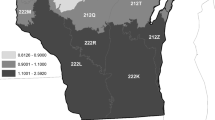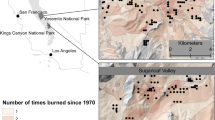Abstract
We investigated differences in vegetation composition and dynamics for two globally rare ecosystems, bracken–grasslands and northern–dry forests of northern Wisconsin. These ecosystems commonly have been viewed as degraded pine barrens. Bracken–grasslands contained a high dominance of exotic species, low native richness, and no obvious prairie species, suggesting logging-era anthropogenic origins. Differences in cover for common plants among ecosystems were examined using Mann-Whitney U tests of equivalence. Cover of all 8 graminoid species, 4 of 5 Ericaceae and Myricaceae species, and 10 of 17 species of forbs were significantly different between ecosystems. Vegetation changes over a 4-year period were examined through detrended correspondence analysis (DCA) and analysis of variance (ANOVA) repeated measures. DCA analyses of community composition failed to detect significant temporal trends within individual management units, although differences were apparent between ecosystems, regardless of sample year. In addition, no apparent patterns could be detected between years when comparing dominant individual species to management history (prescribed fire). This is contrary to what would be expected for a degraded pine barrens and questions the efficacy of using repeated prescribed fire as a management tool in bracken–grasslands. Methods for conservation and restoration of xeric ecosystems of northern Wisconsin have historically relied heavily on single species (e.g., sharp-tailed grouse) wildlife models, without full consideration of other factors. We suggest that stakeholders involved in these restoration projects examine historic processes and reference conditions prior to formulating management goals. Greater attention to the differentiation and individual management needs of pine barrens, northern–dry forests, and bracken–grasslands is needed.


Similar content being viewed by others
References
M. D. Abrams (1992) ArticleTitleFire and the development of oak forests. BioScience 42 346–353
R. J. Cabin R. J. Mitchell (2000) ArticleTitleTo Bonferroni or not to Bonferroni: when and how are the questions. ESA Bulletin 81 246–248
L. Clayton (1986) Pleistocene geology of Florence County, Wisconsin. Information Circular 51. University of Wisconsin Extension, Wisconsin Geological and Natural History Survey Madison, Wisconsin
J. T. Curtis (1959) The vegetation of Wisconsin. The University of Wisconsin Press Madison, Wisconsin 657
D. E. Ferguson R. J. Boyd (1988) Bracken fern inhibition of conifer regeneration in northern Idaho. Research Paper INT-388. US Department of Agriculture Forest Service 11
R. T. Forman (1998) The pine barrens of New Jersey: an ecological mosaic. R. T. Forman (Eds) Pine barrens: ecosystems and landscape. Rutgers University Press New Brunswick, New Jersey 569–585
H. A. Gleason (1918) ArticleTitleOn the development of two plant associations of northern Michigan Plant World 21 151–158 Occurrence Handle1:STN:280:BimC3szhsVU%3D Occurrence Handle3004694
F. Hamerstrom F. N. Hamerstrom O. E. Mattson (1952) Sharptails into the shadows? Wisconsin Wildlife No. 1. Wisconsin Conservation Department Madison, Wisconsin
F. N. Hamerstrom Jr. (1963) ArticleTitleSharptail brood habitat in Wisconsin’s northern pine barrens. Journal of Wildlife Management 27 792–802
A. Haney R. L. Power (1996) ArticleTitleAdaptive management for sound ecosystem management. Environmental Management 20 879–886 Occurrence Handle8895410
Henderson, R. 1995. Overview of Wisconsin’s Biological Communities. Pages 40–49 in Wisconsin’s biodiversity as a management issue: a report to Department of Natural Resource Managers. PUB-RS-915 95. Madison, Wisconsin.
M. O. Hill (1979) DECORANA: a FORTRAN program for detrended correspondence analysis and reciprocal averaging. Ecology and Systematics. Cornell University Ithaca, New York 30
G. F. Levy (1970) ArticleTitleThe phytosociology of northern Wisconsin upland openings. The American Midland Naturalist 83 213–237
M. J. Mossman E. Epstein R. M. Hoffman (1991) ArticleTitleBirds of Wisconsin pine and oak barrens. The Passenger Pigeon 52 153–168
Neimuth, N. 1993. Response of grassland/savanna birds to pine barrens savanna patch size, origin, and structure: preliminary investigations. Page 23 in The future of pine barrens in northwest Wisconsin: a workshop summary, 21–23 September 1993. Solon Springs, Wisconsin.
S. E. Nielsen A. Haney (1998) ArticleTitleGradient responses for understory species in a bracken grassland and northern dry forest ecosystem of northeast Wisconsin. Transactions of the Wisconsin Academy of Sciences, Arts, and Letters 86 149–166
R. L. Power A. Haney (1998) ArticleTitleAdaptive management: a solution to restoration uncertainties. Transactions of the Wisconsin Academy of Sciences, Arts, and Letters 86 177–188
V. C. Radeloff D. J. Mladenoff H. S. He M. S. Boyce (1999) ArticleTitleForest landscape change: The northwest Wisconsin pine barrens before European settlement and Today. Canadian Journal of Forest Research 29 1649–1659 Occurrence Handle10.1139/cjfr-29-11-1649
M. M. Shively S. A. Temple (1994) An ecosystem recovery plan for Wisconsin pine–shrub–grassland ecosystems (pine barrens). University of Wisconsin-Madison, Department of Wildlife Ecology Madison, Wisconsin 82
J. H. Stoeckeler G. A. Limstrom (1942) ArticleTitleSite classifications for reforestation on the national forest of Wisconsin. Journal of Forestry 40 308–315
S. A. Temple (1992) Population viability analysis of a sharp-tail grouse metapopulation in Wisconsin D. R. McCullough R. H. Barrett (Eds) Wildlife 2001: Populations. Elsevier Applied Science London 750–758
R. J. Vogl (1964a) ArticleTitleVegetation history of Crex Meadows, a prairie savanna in northwestern Wisconsin. The American Midland Naturalist 72 157–175
R. J. Vogl (1964b) ArticleTitleThe effects of fire on the vegetation composition of bracken grasslands. Transactions of the Wisconsin Academy of Sciences, Arts, and Letters 53 67–82
R. J. Vogl (1967) ArticleTitleControlled burning for wildlife in Wisconsin. Tall Timbers Annual Fire Ecology Conference 6 47–96
R. J. Vogl (1970) ArticleTitleFire and the northern Wisconsin pine barrens. Tall Timbers Annual Fire Ecology Conference 10 175–209
E. G. Voss (1972) Michigan flora: part I, gymnosperms and monocots. Cranbrook Institute of Science Broomfield Hills, Michigan 488
E. G. Voss (1985) Michigan flora: part II, dicots. Cranbrook Institute of Science Ann Arbor, Michigan 724
E. G. Voss (1996) Michigan flora: part III, dicots. Cranbrook Institute of Science Ann Arbor, Michigan 622
B. Walker S. Carpenter J. Anderies N. Abel G. Cumming M. Janssen L. Lebel J. Norberg G. D. Peterson R. Pritchard (2002) ArticleTitleResilience management in social-ecological systems: a working hypothesis for a participatory approach. Conservation Ecology 6 IssueID1 14
N. G. Yoccoz (1991) ArticleTitleUse, overuse, and misuse of significance tests in evolutionary biology and ecology. ESA Bulletin 72 106–111
Acknowledgments
Special thanks go to B. Jessen, the coordinator and program director of the Savanna Partnership at the Sand County Foundation (SCF) during this project. Other personnel from SCF that have helped in ways too numerous to mention include R. Coleman, B. Haglund, L. Kearney, K. McAleese, A. Miller, and J. Scott. B. Haglund provided numerous conversations during analysis. Field help in 1995 was provided by A. Collada, M. Grover, M. Sheehan, and D. Taylor. A. Collada, B. Jessen, R. Power, and M. Sheehan helped during the second field season (1999). N. Cutright and Wisconsin Electric Power Company provided lodging and GIS data through Stagerwalt Land Services, Inc. S. Borren provided logistical support and background on management history. This project was made possible through the Wisconsin Savanna Partnership with funds from the Department of Defense Legacy Project (1995), the Sand County Foundation (1995 and 1999), and MacIntire-Stennis grant number WIS04325 (1999).
Author information
Authors and Affiliations
Corresponding author
Appendix
Appendix
See Table 7.
Rights and permissions
About this article
Cite this article
Nielsen, S., Haney, A. Vegetation Composition, Dynamics, and Management of a Bracken–Grassland and Northern–Dry Forest Ecosystem . Environmental Management 31, 810–821 (2003). https://doi.org/10.1007/s00267-003-0055-9
Published:
Issue Date:
DOI: https://doi.org/10.1007/s00267-003-0055-9




